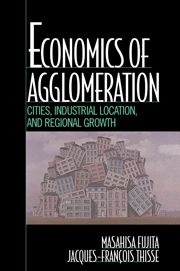Book contents
- Frontmatter
- Contents
- Acknowledgments
- 1 Agglomeration and Economic Theory
- PART I FUNDAMENTALS OF GEOGRAPHICAL ECONOMICS
- 2 The Breakdown of the Price Mechanism in a Spatial Economy
- 3 The Thünen Model and Land Rent Formation
- 4 Increasing Returns and Transport Costs
- 5 Cities and the Public Sector
- PART II THE STRUCTURE OF METROPOLITAN AREAS
- PART III FACTOR MOBILITY AND INDUSTRIAL LOCATION
- PART IV URBAN SYSTEMS AND REGIONAL GROWTH
- References
- Name Index
- Subject Index
3 - The Thünen Model and Land Rent Formation
Published online by Cambridge University Press: 05 June 2012
- Frontmatter
- Contents
- Acknowledgments
- 1 Agglomeration and Economic Theory
- PART I FUNDAMENTALS OF GEOGRAPHICAL ECONOMICS
- 2 The Breakdown of the Price Mechanism in a Spatial Economy
- 3 The Thünen Model and Land Rent Formation
- 4 Increasing Returns and Transport Costs
- 5 Cities and the Public Sector
- PART II THE STRUCTURE OF METROPOLITAN AREAS
- PART III FACTOR MOBILITY AND INDUSTRIAL LOCATION
- PART IV URBAN SYSTEMS AND REGIONAL GROWTH
- References
- Name Index
- Subject Index
Summary
INTRODUCTION
Land use models explain the way various activities using land locate over a given area. This phenomenon can be studied from a different perspective by asking which activities are accommodated in specific locations. As will be seen in this chapter, these two approaches may be considered interchangeable, although they differ somewhat. The first is more in line with microeconomics in that the analysis focuses on where given agents chose to locate, whereas the second is more akin to the approach followed by many geographers, who put the emphasis on places and densities and not on agents.
Because, in a market economy, land is allocated among activities through the price of land, the land use problem is equivalent to asking how the price of land is determined in a competitive economy. This does not seem to be a feasible task, for we have just seen that the price mechanism does not work in a spatial economy. The spatial impossibility theorem does not preclude, however, the possibility of uncovering particular, but relevant, economic situations in which the price mechanism is able to govern the allocation of activities over space. This is precisely what we will try to do in this chapter.
The prototype of such particular situations has been put forward by Thünen (1826), who sought to explain the pattern of agricultural activities surrounding cities in preindustrial Germany. The various models developed in his footsteps can be cast within the Arrow–Debreu framework because transactions must occur at a given marketplace (the town in Thünen's analysis), whereas activities (the crops in Thünen's analysis) and land are supposed to be perfectly divisible.
- Type
- Chapter
- Information
- Economics of AgglomerationCities, Industrial Location, and Regional Growth, pp. 62 - 92Publisher: Cambridge University PressPrint publication year: 2002



